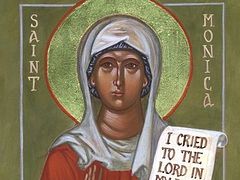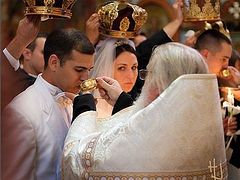Part 3. The First Year of Marriage
Why is it necessary to get crowned in the Church? What is the symbolism of the rings and crowns? Why do the bride and groom stand facing east during the crowning? What does the phrase “to love as you love yourself” mean? What is the proper understanding of the words: “A wife should fear her husband?”
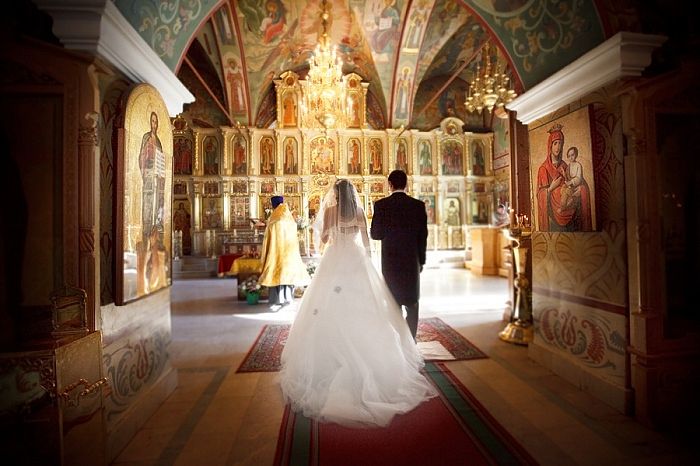
Hello, dear friends. Our series of talks “The Grammar of Family Life” continues with a discussion on the spiritual life of a family and on the beginning of this spiritual life, which is the Mystery of Marriage.
The Mystery of Marriage can be compared with Baptism—with the Baptism of a new family. Here a child is born: having received life from his parents, having received an immortal soul from God he comes forth into the world—but a child needs to be “spiritualized,” to be dedicated to God, to be sanctified in the Mystery of Baptism. And so it is with a family. The creation of a family is always a mystery: two completely different people become one whole, but this union is in need of sanctification—in the Mystery of Marriage.
I have in my hand a Trebnik (Book of Needs)—a book containing the order of services for the Mysteries of the Church which are served in a parish: the Mystery of Marriage, but also the Mystery of Baptism, of Unction, and so on. Today I, having read something to you from it, will speak about betrothals and weddings.
On the Importance of a Church Wedding
Is it necessary to have a Church wedding? Yes, marriage should absolutely be blessed. Many couples come to the church with doubts: “We’re not ready for a Church wedding. Maybe, we’ll think about it and come to the church later…” For believing Church people, the question “is a Church wedding necessary?” is unbearable. If a child is born you must baptize him; if a new union is created you must “spiritualize” it—dedicate it to God.
To begin family life it is necessary to appeal to God for help. We begin any good work with prayer: we serve a Moleben before travel, building a house, and so on; and, of course, before building our family home we must pray purely to God, and the Lord bestows His grace. But God does not save us without us. And the Mystery of Marriage is not some magical action which binds a couple for life regardless of their spiritual condition or faith, and then everything will go just fine, according to their best-laid plans. Of course, any Mystery and even any rite, such as the blessing of automobiles, is not effective without a person’s faith: if a person thinks that a priest should do everything for him, and he himself makes no effort, doesn’t pray, has no intention of obeying traffic laws, it is clear then that it won’t help him at all. In marriage it’s precisely the same: spouses must maintain a Christian spiritual life, must pray for one another, must be Orthodox Christians, and must, naturally, themselves call upon the power of God for help and believe in the power of the Mystery celebrated, in which God will help them.
Betrothal
The Mystery of Marriage begins with the Betrothal. Betrothal is a rite (not the sacrament yet), in which the spouses exchange rings. By the way, the Betrothal in antiquity, in the first centuries, wasn’t a Christian rite: it was accompanied by a legal registration of the marriage. This is how it is in Russia today, where the Church is separate from the government. The Sacrament of Marriage is celebrated separately from the civil registration of the marriage, which happens at the city hall. There was such a situation in the Russian Empire too. Any marriage—something that was blessed and crowned by a bishop and later by priests—must have legal registration. Thus the Sacrament of Marriage has two components: legal and spiritual.
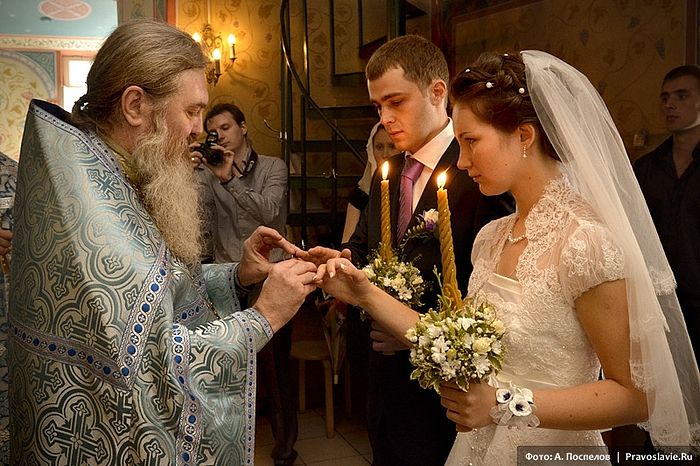
The rite of Betrothal was celebrated by the exchange of rings upon signing a particular marriage document in the presence of witnesses—the Roman Empire very strictly followed the records of civil status, the observance of laws, and the norms of Roman law.
The rite of Marriage, which is now celebrated in the Church on the required days, developed over the centuries and formed up through the fourteenth. It is difficult to say how they served weddings in the first centuries. But one thing we know: the bishop stood the young couple, who had legally registered, in the Church, read a certain prayer, blessed them, and together they communed at the Divine Liturgy. The echo of this joint Communion at the Divine Liturgy is the common cup which the spouses drink during the Wedding.
So, the betrothal. The spouses exchange rings—the priest changes their rings. According to strict Orthodox Tradition, the bride wears a golden ring and the groom a silver one. But in fact they are not their rings: the groom as if wears the ring of his bride, because silver is a symbol of the moon, which receives its light from the sun; and the bride wears the ring of the husband—golden, like the sun. Why exchange the rings? So that the husband and wife might remember one another at all times. Recall that rings, a closed circle without beginning or end, is a symbol of eternity and infinity. This exchange of rings can be compared with banded birds; in seminary the monks joked about the married students, calling them “banded,” and congratulating their classmates with their “banding.” I don’t think there’s anything offensive in this joke; after all, what does it mean to be banded? It means that you belong to someone else. A banded bird has a master who oversees it and sets certain rules for it…
So, a priest, by the authority given him by God, exchanges the couple’s rings, putting the groom’s ring on the bride’s finger, and the bride’s ring on the groom’s finger. Usually the rings are made according to the size of the person who will wear it, because a man’s fingers are bigger than a woman’s, and strictly speaking you shouldn’t remove the ring from your finger. But all the same, you must always remember when looking at your ring that it’s the ring of your spouse who has been given to you in betrothal.
Further, particular prayers are read and litanies are proclaimed in which a blessing and help for the spousal life is solicited; and then immediately afterward begins the Sacrament of Marriage.
Marriage
I will focus only on the main points of this sacrament, because the format of our conversation doesn’t allow for a deep study of it.
First is the Litany of Peace, in which in addition to the regular petitions are added special ones about peace, love, harmony, the granting of children to the couple and the blessing of their common life.
Next we read three prayers in which are mentioned Old Testament righteous who succeeded in family life: Abraham and Sarah, Joachim and Anna, Zechariah and Elizabeth and other saints whom we venerate as a rule of faith and an image of meekness in married life and with whom we align ourselves in our own family life.
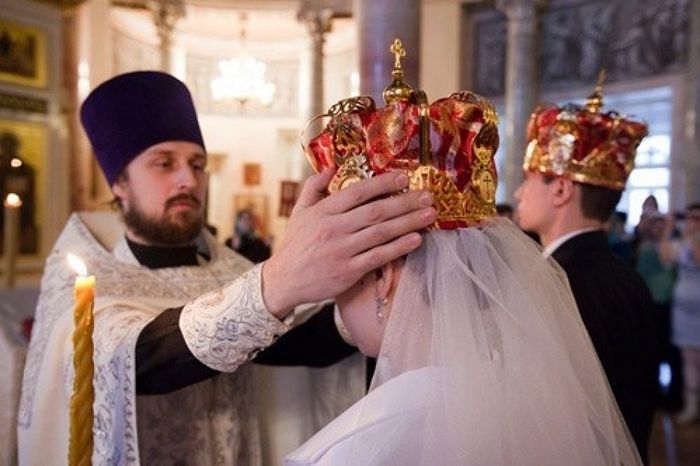
Then follows the Sacrament of Marriage itself: the priest places the crowns on those being wed; therefore the Mystery is called a crowning. By the way, this rite was not immediately either, but we know it was already in use by the fourth century because St. John Chrysostom already wrote about the crowns. What are the crowns for? The Holy Fathers said this: it is, on the one hand, a martyric crown, and people receive the crowns for some kind of podvig. The martyr is crowned for faithfulness and steadfastness in his confession of Christ. Spouses are crowned as people who have maintained their faithfulness to one another and preserved their virginity and chastity until their married family life. But crowns also have the meaning of crowns of royalty, as if a new kingdom is created—the family, where you have a king and queen. Earlier these people lived in the house of their parents where they weren’t the masters, but now begins a new stage in their lives. The king and queen will have their subjects—children. Metropolitan Anthony of Sourozh has noted that in antiquity the couple being crowned were called “prince and princess.” So these crowns are a symbol of authority—the crowning of a new kingdom.
Next comes the very important reading from the Epistle to the Ephesians by the Apostle Paul about the duties of the husband and wife in relation to one another. Here is revealed the depth of the Wedding service. After all an Orthodox crowning is an image of the union of Christ and the Church. As Christ is the head, the savior of the body, as the Apostle Paul says, which is His Church, and the bride of Christ is the Church, and the Lord is ready to give His soul for the Church, which He did, offering for us and for all the great sacrifice on the Cross, so is a husband ready to sacrifice for his wife the most important, most valuable things in life if necessary. For the husband is the head of the wife, even as Christ is the head of the Church: and he is the savior of the body. Therefore as the Church is subject unto Christ, so let the wives be to their own husbands in everything. Husbands, love your wives, even as Christ also loved the Church, and gave himself for it (Eph. 5:23-25). Here it speaks about how the Church should obey Christ and how Christ should care for the Church, be the head of the Church. And a husband, as the head of the church—a family is a tiny church community—is compared with Christ. Families have such a title—“little church,” or “home church.”
Why is the family a little church? We know that the Lord created the human race as a family—from the beginning as the family of Adam and Eve, then as the Church of God. Even monasteries are an image of the family, where people call one another “brothers in Christ” or “sisters in Christ” under the authority of a single father, for example, an abbot or abbess. Man is not saved alone but in community. Interacting with one another, serving one another, we are saved. The most important task in starting a family is precisely the salvation of its members: together we walk towards salvation. It’s not without reason that during the Mystery of Marriage we look in a very important direction—towards the east, with the couple not standing facing one another, turning to one another only when they are congratulating one another and kissing one another at the end of the sacrament of the crowning… But they look, standing side-by-side, holding lit candles, precisely to the east—that is, together they move towards Christ. As Antoine de Saint-Exupery said: lovers are not those who look upon one another, but those who look in the same direction. For us it is precisely the direction of the head Himself—the east.
We can also say this about the husband and wife in this little church: the husband is the head, as if he were the high priest, and the wife is compared with a deacon—the second degree of the priesthood—with a servant. The word “deacon” is translated as “servant”—during the celebration of the Mysteries. And their children—Behold I and the children whom the Lord hath given me—are the parishioners of this little church. The task of this family vessel is salvation: For where two or three are gathered together in my name, there am I in the midst of them (Mt. 18:20)—it is the most important thing for which we serve the Wedding, and for which we bless marriage as a little church.
By the way, some elements of the Wedding are very similar to priestly ordination: a priest is also led around the altar as the spouses are led around the analogion, and we sing the same hymns, just in a slightly different order. As a priest marries the Church, so the groom marries his bride.
Then it speaks—and this is a very important point—about the duties of a husband: So ought men to love their wives as their own bodies. He that loveth his wife loveth himself. For no man ever yet hated his own flesh; but nourisheth and cherisheth it, even as the Lord the Church (Eph. 5:28-29). That is, the future bride is compared with the body of the husband. There is an expression: to love, as you love yourself. Some think that this is somehow something passionate—a special kind of love, but this expression has a completely different meaning. Each of us wants to be respected, pitied, honored, taken care of—this is what it means “to love, as you love yourself.” No one wants to be nagged, to be teased endlessly, to be treated poorly, that his responsiblities go unfulfilled… It’s really very simple: you don’t want to be treated poorly, so don’t do it to someone else; you want kindness, and to be well-liked—so relate to others in this way.
But in this passage from the apostle’s epistle read at the Wedding is commanded a great love: husbands are commanded to love their wives as Christ loves the Church. And what did Christ do for the Church? He gave His life for it. Do we love ourselves with such love? We won’t harm ourselves. But for the sake of our loved ones we can do something at our own expense. When a family member gets sick, a child for example, I think that any normal parent would undoubtedly give their own kidney for him, if necessary; and give their second one, give their life, and sell their apartment so that the their child might live, that he might be healthy… And you love any person close and dear to you even to your own detriment, which means you love him even more than you love yourself. It’s the highest love that the Lord commands in the Mystery of Marriage, and it is quite well revealed in the Epistle reading.
The last words of this reading are and [let] the wife see that she fear her husband (Eph. 5:33). Usually some thunderous reader or deacon proclaims this throughout the whole church, and all are in awe, and someone begins to smile, remembering some story from his life. What does let the wife … fear her husband mean? Firstly, recall that it said in the Apostle Paul before this: Let every one of you in particular so love his wife even as himself (Eph. 5:33), that is, to love, as was said, as Christ loves the Church. And what does let the wife … fear mean—what does “fear” mean? As is often the case, the word “fear” has very many meanings. We know, for example, the words of the Psalmist David: Serve the Lord with fear and rejoice in Him with trembling (Ps. 2:11). So fear is precisely some trembling—it is a relationship of awe. It’s not fearing some kind of punishment or despotism from your husband—it is the fear to humiliate or offend your beloved, a near and dear one. Wives should feel precisely this fear towards their husbands.
Then we read the Gospel that everyone knows about how the Lord was present at the wedding in Cana of Galilee and He blessed this marriage, performing their His first miracle—turning water into wine. Met. Anthony of Sourozh, commenting on this passage, speaks about that in the marital life there can come a moment when people can exhaust their reserve of love, when their relationship begins to cool, and then they must especially supplicate God’s help and intercession to replenish these empty vessels of their souls, their love with new wine and a new grace of God, which the Lord naturally grants.
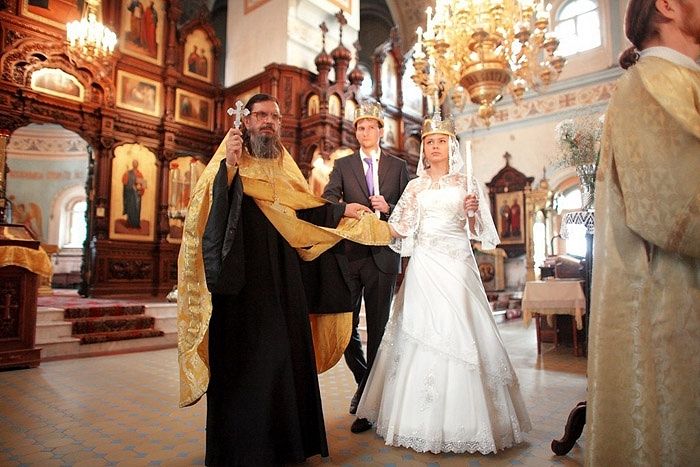
Then the couple is lead around the analogion as a symbol of eternity and joy, as in Baptism we are led around the font. After this follows the removal of the crowns after some time and the congratulations to the newlyweds. With this ends the Sacrament of Marriage.
* * *
And now a few words on the spiritual life of a family. The spiritual life in a family stems, essentially, from the Mystery of Marriage. The family is a little church, as I already said, and spouses should not only solve problems of how to raise children, or some economic issues and so on. A couple’s most important task is salvation—in order to be together not only here, but also in eternity, with one another and with their children. And as St. John Chrysostom noted, the task and responsibility of the husband is to care not only for the spiritual upbringing of his children, but also for the spiritual upbringing of his wife. That is, a husband must always be a few steps ahead of his wife—she shouldn’t have to drag him to the Sacrament of Marriage, then to his first Communion, and so on; but a husband must be the head, in front of this small ecclesial ship. And may the Lord help you in this difficult but very blessed, very salvific, very happy family sailing! May the Lord and the Mother of God preserve you all!


